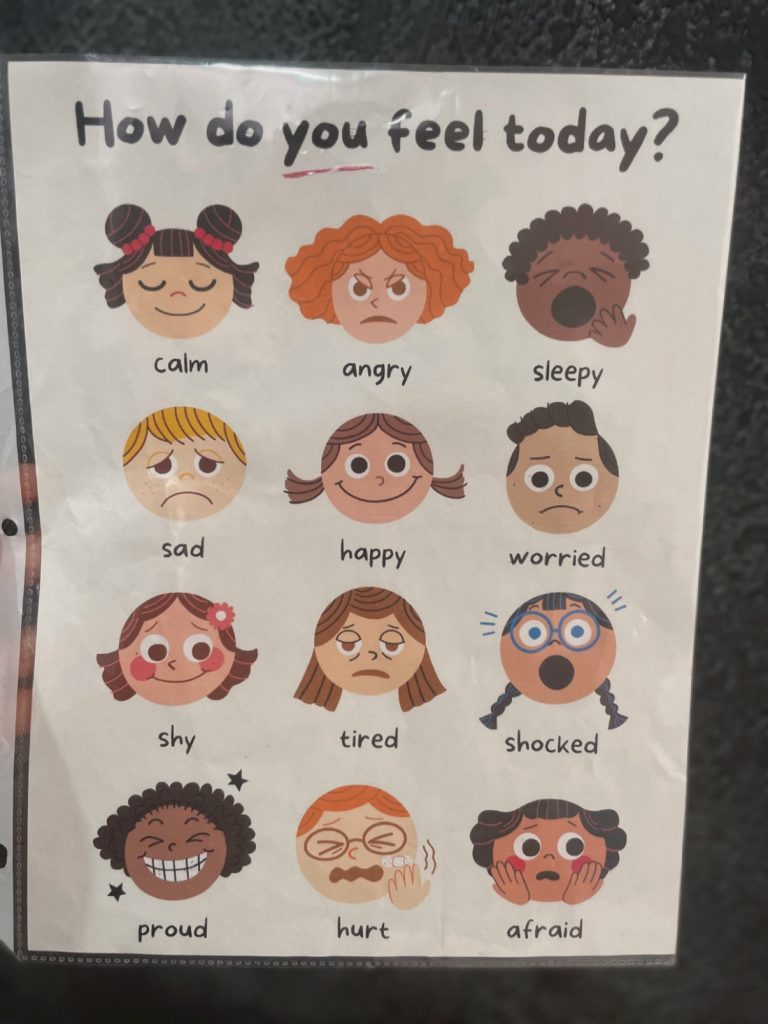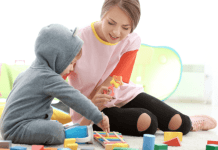As our children grow and develop their emotional skills. It’s our job as parents to help foster their ability to identify and express their emotions.
At first, when my child started throwing tantrums and acting out, I didn’t know what to do! I had so many questions. “Why is my child acting this way?” “How can I help my child identify and express their emotions in a healthy way?”
 Here are some tips I learned along the way through research and from taking childhood development classes in college.
Here are some tips I learned along the way through research and from taking childhood development classes in college.
1. Incorporate a feelings chart into your child’s routine.
Sometimes when I ask my daughter or my niece, “How do you feel?” their response is vague or simply, “I don’t know.” However, when I show them a feelings chart after school or in the morning, I get a more specific response which is great.

A feelings chart can help your child point out how they feel and identify their emotions. I use this chart every day. The kids and I both love it!
2. Help your child identify and express their emotions by listening.
Listening goes a long way. Sometimes as adults we just want someone to listen to us. Children want the same thing. Listening to our children is important especially when it comes to their feelings.
Below is a book read aloud called “The Rabbit Listened.” This book not only opened my eyes but helped me and my daughter to understand the importance of listening and how children feel sometimes when things don’t go their way.
3. Give your child reassurance.
Reassure your child that it’s ok to feel angry or sad sometimes. But also state the importance of expressing their emotions in healthy ways.
As a result, you will help your child identify and express their emotions by providing a safe place for them to do so.
4. Lead through example.
Our children are watching everything we do. So we have to keep in mind that it’s important to respond to our children’s emotions in a healthy way.
The way we respond to our children can affect their interpersonal relationships. Our parenting response can also affect our kids’ emotions well into adulthood. The video below explains more.
5. Help them deal with negative emotions.
Sometimes children can get into this notion (or learned behavior) that they can just cry and scream and then they’ll get whatever they want. Of course, this isn’t a healthy way to express their emotions. So how can we deal with these negative emotions?
First of all, set rules and model the behavior you want to see in your child.
I’ll admit I have played into my child’s negative emotions and tantrums by saying “fine..here… stop crying!” However, I have also been able to find a better solution to certain issues by setting up some ground rules and modeling appropriate behaviors.
For example, No means No. Don’t argue back with your child or get extremely angry. Just give them a firm No and you can later explain to them (when you and their emotions calm down a bit) why you said no.
Secondly, teach children about consequences in a healthy way.
Utilize time-outs, or limit screen time if your child is expressing their feelings in a way that can cause harm to themselves or others.
By doing so, you will help teach children that there will be consequences for their behavior. There are consequences for adults who express their emotions towards each other in an unhealthy way. Let’s teach our kids when the consequences don’t have lifelong implications.
6. Learn about childhood development.
As a child develops, they will learn to utilize their emotional skills. We can help them by understanding their development and stages of learning. The following video is a brief introduction.
Lastly, take a deep breath! You’re not alone in this. Keep learning, teaching, and pushing through. Your child will begin to identify and express their emotions in a healthy way. You’re doing a great job mama. You and your child got this!
How do you help your child identify and express their emotions? Let us know in the comments below.
The opinions expressed in this post are those of the author. They do not necessarily reflect the official policy or position of El Paso Mom, its executive team, other contributors to the site, its sponsors or partners, or any organizations the aforementioned might be affiliated with.









